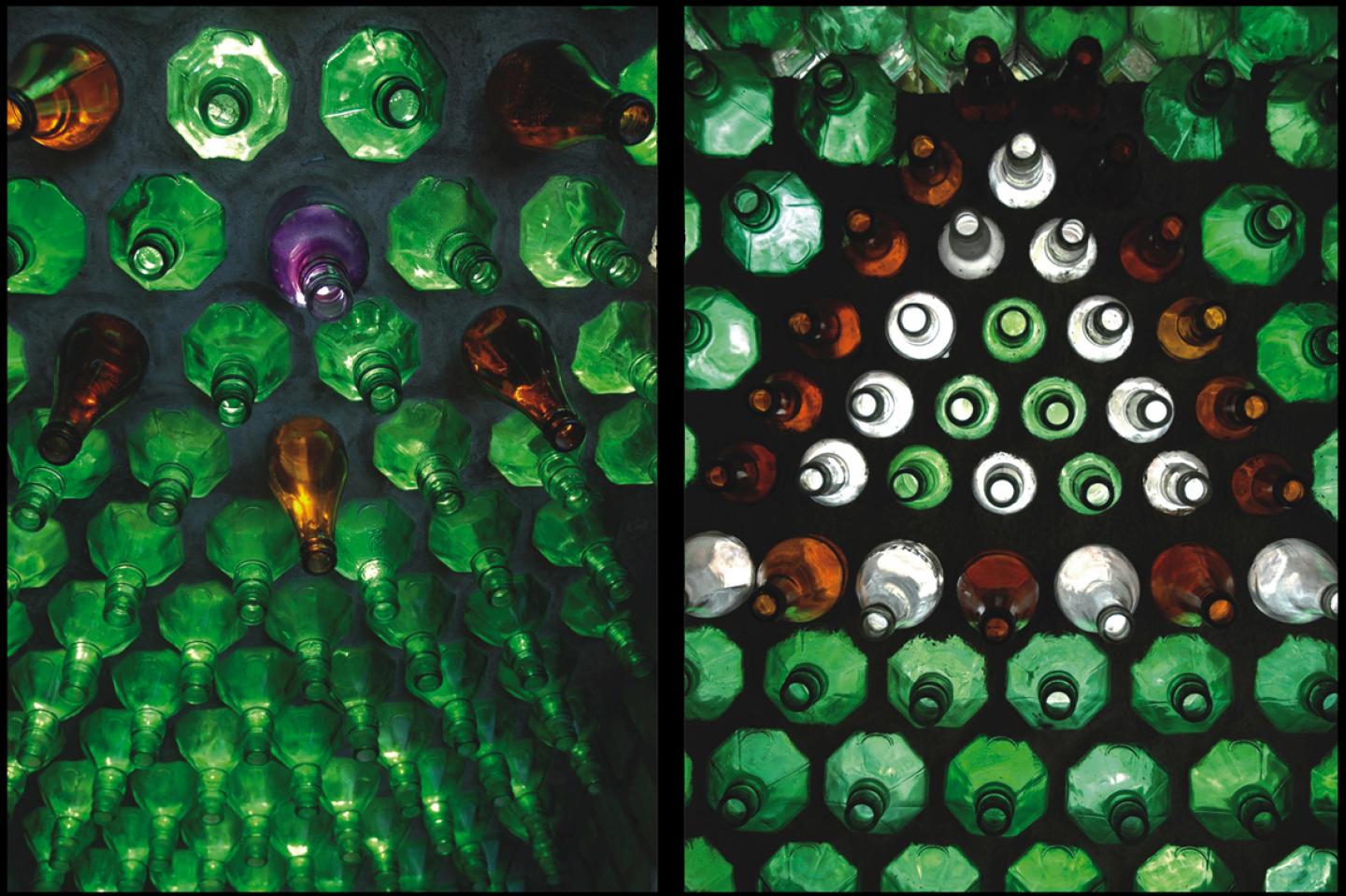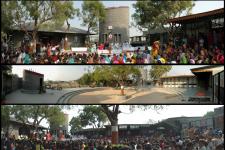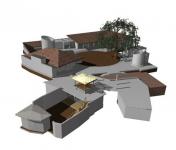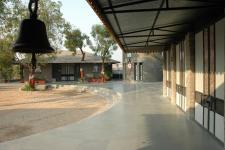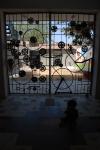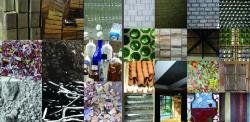Nearly 27.4 million tonnes of waste is produced daily in the urban centers of India. Cities like Ahmedabad alone produce 2750 metric tonnes. Unfortunately nothing really gets processed of the same. This waste is simply dumped openly in the landfill sites, which uses enormous volumes of fossil fuel, creating an altered, polluted, unsafe and unhealthy landscape. Thankfully India has a well-established tradition of waste recycling which is clearly demonstrated in daily practices and lifestyle. Food along with many other objects, are given added value for their multiple uses and diverse applications even after its primary life cycle. Can the building industry not learn from these applications? An activity centre at Rama Pir Tekra, Wadaj in Ahmedabad has been one such attempt in the direction of recycling municipal/domestic waste into building materials.
The activity centre is located amidst the largest squatter settlement of Ahmedabad, and was created under the initiative of the social NGO, Manav Sadhna. The multi-purpose activity centre serves as an informal school for young children in the mornings, provides evening education for adults and serves as a vocational training centre and activity workshop for the manufacturing of craft based products by women and elderly during the day. The campus also includes a dormitory, an administrative unit and an all-religion meditation unit. A crèche has been added later to look after the young children when their parents are away earning wages. The community centre apart from becoming interactive place during festivities also doubles up as health centre and Gym on the routine basis.
The campus is built using components prepared through recycling municipal/domestic waste. This process simultaneously addresses environmental concerns, economic issues and affordable housing. As municipal waste from the domestic sector is used for producing building components, it helps to reduce pollution. Through value addition processes of recycling the waste, it provides an economic activity for the poor as well as a sense of empowerment. Finally as the recycled building components are cheaper and of higher quality than the conventional materials, they provide affordable and superior quality building alternatives for the urban poor. Thus a holistic improvement in the quality of life.
Construction:
The campus is built as a live demonstration for the application of recycled waste as affordable, aesthetically pleasing and efficient building components. The products developed for this project, which incorporate municipal/domestic waste and are prepared with simple hand operated tools, and produced partly through local help of the end users, are demonstrated in the walls, roofs/slabs, doors and windows. There are six types of materials and techniques used in the making of the walls. These include: cement bonded fly ash bricks, mould-compressed bricks made from landfill site waste residue, stabilized soil blocks, recycled glass bottles, recycled plastic bottles filled with ash and waste residue, and vegetable crate wood paneling in the inner partition walls.
Similarly the floor and roof slabs as applied in the activity centre include: filler slab with glass bottles, plastic bottles and bricks, stone slab, cement bonded particle board with clay tile cover, as well as light conduit pipe truss with G.I. sheet with clay tile roof.
The door paneling uses shredded packaging wrapper and coated paper waste as reinforcement substitute for fiber reinforced plastic (FRP). Vegetable crate wood as a frame and oil tin container as blades make the ventilation louvers in the toilets. A paneled door using vegetable crate wood and oil tin containers for the frame and cladding respectively is also provided in the administrative block office toilet. Fly ash and waste residue moulded tiles with inlaid ceramic industry waste as china mosaic (applied during tile moulding itself) is also applied in patches for their demonstration.
All of these products are developed and produced first hand. The products thus produced have been lab tested for their engineered performance and they prove to be economical, environmentally friendly, participatory and aesthetically pleasing solutions and express alternatives to contemporary practices.
Project significance and impact:
Non-polluting environment, economic empowerment and affordable built forms are the three key dimensions of this initiative. The project is an outcome of over three years of empirical research, with the goal of effectively converting municipal waste from the domestic sector into functional building components. First hand experiments and onsite explorations have led to the development of innovative building components that use waste, simple hand- operated tools and local resources and know-how. The project also demonstrates that building can become an economic activity, empowering the poor. It shows potential of becoming a cottage industry for economic self-reliance and possibilities to improve the quality of their homes using the affordable alternative building components. Manavsadhna activity centre and the crèche are located amidst one of the largest squatter settlements of Ahmedabad. As multi activity centre it performs as school in the morning, vocational training centre in the afternoons, health centre and gymnasium in the evening and as community centre and festivity point in the late evening hours.
The building, apart from its flexible layout allowing the multipurpose activities, serves as an open book, demonstrating the conversion of the domestic and municipal waste into affordable, effective and aesthetic building components. This is conceived as a live demonstration of these concerns and placed amongst the people so users can emulate them in their own habitat. The project has ably demonstrated application of nearly twenty types of recycled waste. These applications cover the alternative components for Roofing, flooring, walling as well as fenestrations. While the waste ranges from Fly ash of the thermal plant to dump fill site garbage hip to wooden crate or even plastic bottles or the glass. All of these have successfully provided for the walling option. Rags, Wrappers, and packaging materials have also been made use of as raw material. Wooden crates for vegetable and fruit boxes as well as even empty oil tin containers are used to create doors, windows and ventilators. Ceramic industry’s waste which does not get recycled for any other use is converted to become flooring options in tiles or paver blocks. Even construction industry’s waste has been ably used here. These include broken stone and tile residue, metal scrap, stone cutter blades, re bars of broken slabs and even bathroom fixtures. The alternative building components created through such waste recycling have been lab tested for their strength and other performance criteria, which they successfully fulfill. Task performance and costs were the basic bottom lines with which they were created, so the newly developed components and building techniques continue to be comparable by cost but in addition they remain better performing and aesthetically pleasing.
The demonstration has had several positive indicators and spinoffs so far. The activity centre has been in intense use for nearly past three years. The centre has become identity and landmark of the settlement where all festivals are celebrated collectively. Many activities for youth and community have grown and added over time and this has demanded expansion of the premise. After the activity centre, the campus of crèche has been added in the adjoining site. Even this centre not only has explored the same theme of recycling but has further explored the additional palette of waste from the construction industry. One more centre for the economic and craft based production activity of the local women is also currently being built on the similar concepts. Even local people have emulated some basic components such as t in paneling doors, crate walls etc. Builders have shown interest in using some of the components such as mosaic tiles or paver blocks or rag reinforced FRP panels etc if mass produced. The fly ash blocks are being ass produced and successfully used for number of sites across the town. The centre construction process was participatory and many local people participated with their skilled and unskilled labour and earned wages through the same. So building activity in itself proved to be the economic one. The concerns demonstrated in the design and construction has been well appreciated by the construction fraternity and the project has been a role model for students and professionals in other urban centres to emulate. The project got nearly ten National and International awards for its design, innovative use of construction material to environmental concerns.
- Yatin pandya
2005
2008
Ulrike, Suchita, Riddhish, Kunal, Lti, Nirmit, Rajesh, Harshita, Kanika, Naagraj, Tejal
